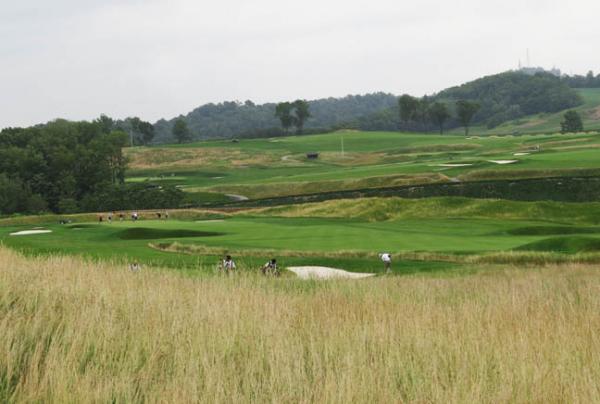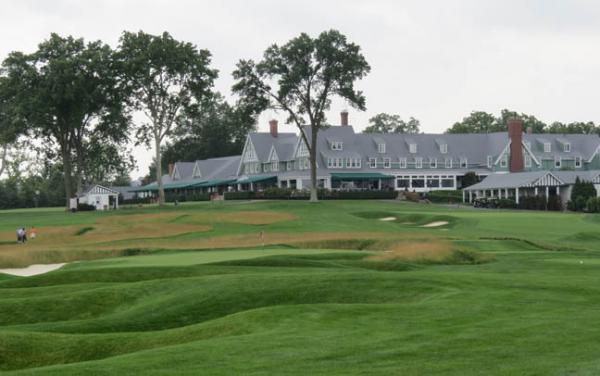
The world's best players likely won't be wearing plus-fours next June when the U.S. Open returns to Oakmont Country Club, but they wouldn't be out of place if they did.
The removal of even more trees since the 2007 U.S. Open and 2010 U.S. Women's Open has the course looking and playing more like it did when iron industrialist Henry Fownes built a links-style course on a bluff along the Allegheny River upstream from Pittsburgh in 1903 than it has at any time in the last half century.
As the dust settles on this year's Open at Chambers Bay, Oakmont superintendent John Zimmers and his bunch are busily preparing for next June, when the pros will descend on Western Pennsylvania. And when they do, galleries at Oakmont will be able to see action on nearly every hole regardless of where they are standing. About the only barrier standing in the way of patrons will be their own height.
Sure, the fronts of some bunkers have been shaved down at the behest of the USGA's Mike Davis to funnel more balls into harm's way, but any architectural changes begin and end there. The real story for the 2016 U.S. Open is going to be open vistas and wind ? a lot of wind.
"We haven't really done anything architecturally since '07, so there are a lot of similarities," said the 44-year-old Zimmers, who has been superintendent at Oakmont since he was 28 years old. "But the views are going to be much different."
From a point east of Pennsylvania's Turnpike near the third green and fourth tee, it's possible to see virtually the entire golf course. From there, only Nos. 13 and 16, two par 3s near an irrigation pond on the north side of the property, are not within sight. It is possible to see just about the entire golf course from much of the back nine.
"You can stand on (No.) 7 and see people putting on (No.) 12," Zimmers said. "It's going to be fabulous for the gallery."
It wasn't always like that here.
During the run-up to the 2007 U.S. Open, Oakmont made headlines for an aggressive restoration plan that included the removal of some 5,000 trees across the property, a move that accomplished at least four goals: it improved turf health, improved spectator views for USGA championships, returned the course to what Fownes envisioned more than a century ago, and it opened the door to wind becoming a factor on a course already noted more than any other for its treachery.
Oakmont is a place with a history of surprises for golfers, so just when it seemed like there wasn't another tree there worth touching, Zimmers found some. He and his staff started taking down more trees immediately after the 2010 U.S. Women's Open. The project shifted into hyper mode last summer when a storm mangled a wooded area between the 11th and 12th holes.

Members noticed a difference right away, as cutting down some of the damaged trees improved views on what already had become an open golf course.
"We went in and removed some of those trees, and people were like 'Wow.' They could really see the difference," Zimmers said. "That allowed us to go in and say 'You know what? Let's finish this.' "
After clearing the area behind the 12th green, crews and contractors moved on and cleared out the hillsides along the turnpike and railroad tracks that divide the property. When all was said and done, an estimated 7,000 additional trees had come down.
Taking out trees is a controversial decision at almost any golf course. Removing some 12,000 of them at a place like Oakmont with its legacy of championship golf is not something that is done hastily.
Most of the thousands of trees responsible for converting Oakmont from a links-style course to a parkland setting had been planted during the 1960s. Like them or not, they had become part of Oakmont's personality. The idea of removing them had both fans and detractors, and thus it has been a process that has taken years to accomplish.
"You have to start small. That's why it's taken such a long time," said Zimmers, who has been removing trees in increments since he started at Oakmont in 1999. "A majority of the people thought it would be really good, because you could see a little bit more, and some people have the foresight to be able to see that. But there were others who said 'I don't know if I'd do that. You're going to hear the turnpike more; you're going to see the (turnpike) sign.' At the end of the day, everyone has embraced this. They realize that the turnpike is part of who we are here, and the railroad tracks are part of who we are."
 Oakmont is well known for its tough-to-please members who like showing the USGA and the pros a thing or two every time they pass through Pittsburgh. They fancy lightning fast greens that can break your heart and conditions that can break your spirit. Whether it's for the U.S. Open or a member-guest, the higher the score, the more golfers here like it. The tree-removal project has been a hit with them, not only because of the views, but because the wind makes a grueling experience even more challenging.
Oakmont is well known for its tough-to-please members who like showing the USGA and the pros a thing or two every time they pass through Pittsburgh. They fancy lightning fast greens that can break your heart and conditions that can break your spirit. Whether it's for the U.S. Open or a member-guest, the higher the score, the more golfers here like it. The tree-removal project has been a hit with them, not only because of the views, but because the wind makes a grueling experience even more challenging."The wind is more of a factor now than it's ever been," Zimmers said. "The members like it because it makes the course harder, and it dries the course out faster, making it play faster."
Although the course arguably is more open than it has been in generations, it has been pinched in a bit, too.
Since he arrived 16 years ago, Zimmers has been gradually converting managed turf to non-irrigated naturalized areas. To date, he has converted about 80 acres to a mix of Chewings, hard and sheep fescues.
"People say 'hey, you need to let those areas go natural.' Natural areas, if you don't take care of them, turn into weeds," Zimmers said. "By converting to fescue from fine-cut turf, we still have fewer inputs, less maintenance and it looks fantastic."
At Oakmont, difficult conditions have always been about the greens, those famous Oakmont Poa greens.
The strain of Poa found at Oakmont is believed to grow only in Western Pennsylvania. Attempts to propagate it elsewhere have failed through the years. Each year, it takes a pounding from Mother Nature. And each year, it comes back as strong as ever to deliver a blow to golfers as subtle as a punch to the head.
"Keeping those greens going is our biggest challenge," Zimmers said. "People always say 'just seed it.' But we don't have anything to seed it with. You can put bentgrass down. That's fine as a filler, but it won't last long. It can't take a beating like our Western Pennsylvania Poa."
It can't deliver one like it either.

